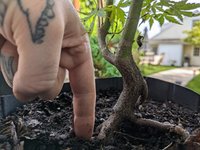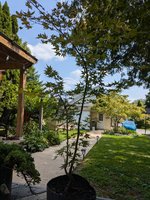Likebull1
Mame
I went to a new nursery today about 20 minutes from my house and I went specifically for a juniper I saw there last week.
I was walking around and saw about 20 of so what I believe to be cut leaf Maples. They all had pretty straight trunks except this one. The nebari is a complete mess but it was a great deal for only $30 due to the fact it wasn't entered into inventory yet. I definitely want to get it into some better soil next year but I was wondering if I should ground layer it before I repot it or let it recover/grow/airlayer.
I'm still pretty new to the maple game so any advice will be appreciated.
I was walking around and saw about 20 of so what I believe to be cut leaf Maples. They all had pretty straight trunks except this one. The nebari is a complete mess but it was a great deal for only $30 due to the fact it wasn't entered into inventory yet. I definitely want to get it into some better soil next year but I was wondering if I should ground layer it before I repot it or let it recover/grow/airlayer.
I'm still pretty new to the maple game so any advice will be appreciated.



